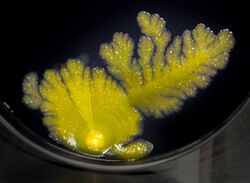Biology:Sphingomonadaceae
| Sphingomonadaceae | |
|---|---|

| |
| A culture of Sphingomonas phyllosphaerae | |
| Scientific classification | |
| Domain: | Bacteria |
| Phylum: | Pseudomonadota |
| Class: | Alphaproteobacteria |
| Order: | Sphingomonadales |
| Family: | Sphingomonadaceae Kosako et al. 2000 |
| Type genus | |
| Sphingomonas Yabuuchi et al. 1990
| |
| Genera[1] | |
| |
Sphingomonadaceae are a gram-negative bacterial family of the Alphaproteobacteria. An important feature is the presence of sphingolipids (mainly 2′-hydroxymyristoyl dihydrosphingosine 1-glucuronic acid, "SGL-1") in the outer membrane of the cell wall.[2][3] The cells are ovoid or rod-shaped. Others are also pleomorphic, i.e. the cells change the shape over time. Some species from Sphingomonadaceae family are dominant components of biofilms.[4][5][6]
Energy source
While most species within Sphingomonadaceae family are heterotrophic,[7] some are phototrophic.
Function
Some species of Sphingomonadaceae are known to degrade some aromatic compounds. This makes the bacteria of interest to environmental remediation.[8]
The diverse metabolic capacity of genera within the Sphingomonadaceae family, such as Sphingobium, Novosphingobium,[lower-alpha 1] and Sphingopyxis enable these genera to adapt to and be abundant in the presence of bisphenol A. A microbial community with abundant Sphingomonadaceae members can degrade bisphenol A with a constant rate.[9]
Some Sphingomonas species are able to produce sphingans, a kind of exopolysaccharides with certain viscosity. This property of sphingans makes it useful in many industries including food and pharmaceutical.[10][7]
Distribution
Bacteria within Sphingomonadaceae family are distributed in various environments, such as water,[5] soil,[11][12] sediment.[7][13]
Phylogeny
The currently accepted taxonomy is based on the List of Prokaryotic names with Standing in Nomenclature[1] and the phylogeny is based on whole-genome sequences.[14][lower-alpha 2]
| |||||||||||||||||||||||||||||||||||||||||||||||||||||||||||||||||||||||||||||||||||||
Interaction with human and plants
Some members of the Sphingomonadaceae commonly exist in human-impacted environments, including drinking water systems,[15][5] hospital and household tap water,[16] and medical devices.[17][18][19]
Most of the species of the Sphingomonadaceae are not known to be harmful to humans or plants.[7] Some species can protect plants from disease-causing pathogens such as Thielaviopsis basicola, and Rhizoctonia solani.[7][12][11][20]
The Sphingomonas and Sphingobium genera tend to have higher antibiotic resistance compared with three other genera within the Sphingomonadaceae: Novosphingobium,[lower-alpha 1] Sphingopyxis, and Blastomonas.[5]
See also
- Dihydrosphingosine
- Glucuronic acid
- 2-Hydroxy acid, for 2′-hydroxymyristoyl
- Myristic acid, for 2′-hydroxymyristoyl
Notes
References
- ↑ 1.0 1.1 "Sphingomonadaceae". List of Prokaryotic names with Standing in Nomenclature (LPSN). https://lpsn.dsmz.de/family/sphingomonadaceae.
- ↑ Bergey's Manual of Systematic Bacteriology. Two The Proteobacteria, Part C: The Alpha-, Beta-, Delta-, and Epsilonproteobacteria. New York, New York: Springer. 2005. ISBN 978-0-387-24145-6.
- ↑ "Molecular characterization of membrane-associated soluble serine palmitoyltransferases from Sphingobacterium multivorum and Bdellovibrio stolpii". Journal of Bacteriology 189 (15): 5749–61. August 2007. doi:10.1128/JB.00194-07. PMID 17557831.
- ↑ "Sphingomonadaceae from fouled membranes". npj Biofilms and Microbiomes 5 (1): 6. 2019-01-25. doi:10.1038/s41522-018-0074-1. PMID 30701078.
- ↑ 5.0 5.1 5.2 5.3 "Diversity and antibiotic resistance patterns of Sphingomonadaceae isolates from drinking water". Applied and Environmental Microbiology 77 (16): 5697–706. August 2011. doi:10.1128/AEM.00579-11. PMID 21705522. Bibcode: 2011ApEnM..77.5697V.
- ↑ "Dynamics of the physiochemical and community structures of biofilms under the influence of algal organic matter and humic substances". Water Research 158: 136–145. July 2019. doi:10.1016/j.watres.2019.04.014. PMID 31026675. Bibcode: 2019WatRe.158..136L.
- ↑ 7.0 7.1 7.2 7.3 7.4 "The Family Sphingomonadaceae". The Prokaryotes. Berlin, Heidelberg: Springer. 2014. pp. 641–707. doi:10.1007/978-3-642-30197-1_302. ISBN 978-3-642-30197-1.
- ↑ "Sphingomonas and Related Genera". The Prokaryotes, A Handbook of the Biology of Bacteria. 7: Proteobacteria: Delta and Epsilon Subclasses. Deeply Rooting Bacteria. 12 October 2006. ISBN 978-0-387-33493-6.
- ↑ "Microbial Community Enhances Biodegradation of Bisphenol A Through Selection of Sphingomonadaceae". Microbial Ecology 77 (3): 631–639. April 2019. doi:10.1007/s00248-018-1263-4. PMID 30251120.
- ↑ "The preparation and characterization of a novel sphingan WL from marine Sphingomonas sp. WG". Scientific Reports 6 (1): 37899. November 2016. doi:10.1038/srep37899. PMID 27883073. Bibcode: 2016NatSR...637899L.
- ↑ 11.0 11.1 "Evaluation of rhizobacterial indicators of tobacco black root rot suppressiveness in farmers' fields". Environmental Microbiology Reports 6 (4): 346–53. August 2014. doi:10.1111/1758-2229.12131. PMID 24992533.
- ↑ 12.0 12.1 "Current Insights into the Role of Rhizosphere Bacteria in Disease Suppressive Soils". Frontiers in Microbiology 8: 2529. 2017-12-18. doi:10.3389/fmicb.2017.02529. PMID 29326674.
- ↑ "Description of novel members of the family Sphingomonadaceae: Aquisediminimonas profunda gen. nov., sp. nov., and Aquisediminimonas sediminicola sp. nov., isolated from freshwater sediment" (in en). International Journal of Systematic and Evolutionary Microbiology 69 (8): 2179–2186. 2019-08-01. doi:10.1099/ijsem.0.003347. PMID 31204973.
- ↑ Hördt, Anton; López, Marina García; Meier-Kolthoff, Jan P.; Schleuning, Marcel; Weinhold, Lisa-Maria; Tindall, Brian J.; Gronow, Sabine; Kyrpides, Nikos C. et al. (7 April 2020). "Analysis of 1,000+ Type-Strain Genomes Substantially Improves Taxonomic Classification of Alphaproteobacteria". Frontiers in Microbiology 11: 468. doi:10.3389/fmicb.2020.00468. PMID 32373076.
- ↑ "Characterization of bacterial community structure in a drinking water distribution system during an occurrence of red water". Applied and Environmental Microbiology 76 (21): 7171–80. November 2010. doi:10.1128/AEM.00832-10. PMID 20851995. Bibcode: 2010ApEnM..76.7171L.
- ↑ "Genotypic diversity and antibiotic resistance in Sphingomonadaceae isolated from hospital tap water". The Science of the Total Environment 466-467: 127–35. January 2014. doi:10.1016/j.scitotenv.2013.06.109. PMID 23892027. Bibcode: 2014ScTEn.466..127N.
- ↑ "Biofilms on Hospital Shower Hoses: Characterization and Implications for Nosocomial Infections". Applied and Environmental Microbiology 82 (9): 2872–2883. May 2016. doi:10.1128/AEM.03529-15. PMID 26969701. Bibcode: 2016ApEnM..82.2872S.
- ↑ "Exploring bacterial diversity in hospital environments by GS-FLX Titanium pyrosequencing". PLOS ONE 7 (8): e44105. 2012-08-29. doi:10.1371/journal.pone.0044105. PMID 22952889. Bibcode: 2012PLoSO...744105P.
- ↑ "Water-borne Sphingomonas paucimobilis epidemic in an intensive care unit". The Journal of Infection 58 (3): 253–5. March 2009. doi:10.1016/j.jinf.2009.01.007. PMID 19232740.
- ↑ "Fungal invasion of the rhizosphere microbiome". The ISME Journal 10 (1): 265–8. January 2016. doi:10.1038/ismej.2015.82. PMID 26023875.
Wikidata ☰ Q577057 entry
 |

